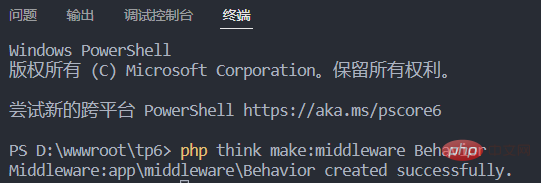Example analysis: how thinkphp uses middleware to record behavior logs
This article brings you relevant knowledge about PHP. It mainly looks at the problem of using middleware to record behavior logs based on examples, including using log channels to temporarily store behavior logs, using Scheduled tasks regularly write log content to the database, etc. Let’s take a look at it. I hope it will be helpful to everyone.

PHP Video Tutorial"
php think make:middleware Behavior
 This instruction will generate a Behavior middleware under the app/middleware directory. The content is as follows:
This instruction will generate a Behavior middleware under the app/middleware directory. The content is as follows:
<?phpdeclare (strict_types = 1);namespace app\middleware;use think\facade\Log;class Behavior{
/**
* 处理请求
*
* @param \think\Request $request
* @param \Closure $next
* @return Response
*/
public function handle($request, \Closure $next)
{
//start 加入以下内容
$admin = get_admin_info(); //当前登录用户的信息,自己实现
$method = strtolower($request->method());
$is_ajax = $request->isAjax();
$route = $request->pathinfo();
$req = $_REQUEST;
unset($req['s'],$req['_session']);
$req_data = $req ? json_encode($req) : '';
$data = [
'admin_id' => $admin['id'], //操作人id
'admin_user' => $admin['user'], //操作人用户名
'route' => $route, //操作的路由地址
'method' => $method, //get/post
'req_tp' => $is_ajax ? 'ajax' : 'normal',
'req_data' => $req_data, //get/post的数据
'ip' => getIp(),
'create_time' => time()
];
//end
return $next($request);
}}
Tips: Read the official log processing tutorial first https://www.kancloud.cn/manual/thinkphp6_0/1037616Log processing
Open config/log.php, add a separate channel for recording behavior logs at the end of 'channels' => []:2. Register global middleware// 其它日志通道配置 //行为日志 'behavior' => [ 'path' => runtime_path().'behavior', //日志存放目录 'type' => 'File', 'single' => 'b', //单一文件日志:文件名 'file_size' => 1024*1024*10, //日志文件大小限制(超出会生成多个文件 'max_files' => 30, //文件最大数量 'realtime_write' => false, // 关闭实时写入 ],Copy after login
Open app/middleware.php and register a behavior log global middleware3. Test whether the log can be successfully generatedVisit any page of this project, for example: http://www.tp6.com/index/index/test?a=1&b=2, and see if the following files can be generated.<?php // 全局中间件定义文件return [ // 全局请求缓存 // \think\middleware\CheckRequestCache::class, // 多语言加载 // \think\middleware\LoadLangPack::class, // Session初始化 // \think\middleware\SessionInit::class // 行为日志 \app\middleware\Behavior::class, ];Copy after login
 Open the file ,The data has been written
Open the file ,The data has been written
{"time":"2022-04-16T21:38:48 08:00","type":"info","msg":"{"admin_id ":888,"admin_user":"fanchen","route":"index\/index\/test","method":"get","req_tp":"normal","req_data":"{\" a\":\"1\",\"b\":\"2\"}","ip":"127.0.0.1","create_time":1650116328}"}
3. Use scheduled tasks to regularly write log content to the database 1. Create a new api method, requiring scheduled tasks to be accessible to
/**
* 定时任务服务器定时将用户行为日志插入到数据库
* @return void
*/
public function sync_behavior_log()
{
$path = runtime_path() . 'behavior/b.log';
$b_file = file_get_contents($path);
$b_arr = explode(PHP_EOL, $b_file);
$d = [];
foreach ($b_arr as $b) {
$data = json_decode($b, true);
if (!empty($data['msg'])) {
$d[] = json_decode($data['msg'], true);
}
}
if ($d) {
try {
Db::name('log_behavior')->insertAll($d); //批量插入数据库
file_put_contents($path, ''); //清空文件日志
echo '采集用户行为日志成功' . count($d);
} catch (DbException $e) {
echo ($e->getMessage());
}
}
}Copy after login
2. Create a new behavior log data table log_behavior /**
* 定时任务服务器定时将用户行为日志插入到数据库
* @return void
*/
public function sync_behavior_log()
{
$path = runtime_path() . 'behavior/b.log';
$b_file = file_get_contents($path);
$b_arr = explode(PHP_EOL, $b_file);
$d = [];
foreach ($b_arr as $b) {
$data = json_decode($b, true);
if (!empty($data['msg'])) {
$d[] = json_decode($data['msg'], true);
}
}
if ($d) {
try {
Db::name('log_behavior')->insertAll($d); //批量插入数据库
file_put_contents($path, ''); //清空文件日志
echo '采集用户行为日志成功' . count($d);
} catch (DbException $e) {
echo ($e->getMessage());
}
}
}SET NAMES utf8mb4;
SET FOREIGN_KEY_CHECKS = 0;
-- ----------------------------
-- Table structure for log_behavior
-- ----------------------------
DROP TABLE IF EXISTS `log_behavior`;
CREATE TABLE `log_behavior` (
`id` int(10) UNSIGNED NOT NULL AUTO_INCREMENT COMMENT 'ID',
`admin_id` int(11) NOT NULL DEFAULT 0 COMMENT '用户id',
`admin_user` varchar(50) CHARACTER SET utf8 COLLATE utf8_general_ci NOT NULL DEFAULT '' COMMENT '用户名',
`route` varchar(50) CHARACTER SET utf8 COLLATE utf8_general_ci NULL DEFAULT NULL COMMENT '模块名称',
`method` enum('delete','put','post','get') CHARACTER SET utf8 COLLATE utf8_general_ci NULL DEFAULT 'get' COMMENT '请求方式 1get 2post 3put 4delete',
`req_data` varchar(300) CHARACTER SET utf8 COLLATE utf8_general_ci NOT NULL DEFAULT '' COMMENT '请求数据',
`ip` varchar(20) CHARACTER SET utf8 COLLATE utf8_general_ci NOT NULL DEFAULT '' COMMENT '用户ip',
`create_time` int(11) NOT NULL DEFAULT 0 COMMENT '创建时间',
PRIMARY KEY (`id`) USING BTREE,
INDEX `uid`(`admin_id`) USING BTREE,
INDEX `admin_user`(`admin_user`) USING BTREE,
INDEX `route`(`route`) USING BTREE
) ENGINE = InnoDB AUTO_INCREMENT = 3902195 CHARACTER SET = utf8 COLLATE = utf8_general_ci COMMENT = '行为日志' ROW_FORMAT = Compact;
SET FOREIGN_KEY_CHECKS = 1;Copy after login
3. Create a new scheduled task Create a new scheduled task and regularly access the sync_behavior_log address in step 1. It is recommended to do so once every 5 minutes. At this point, when a user accesses, The data table will insert behavior log data in batches every once in a while Recommended learning: "SET NAMES utf8mb4;
SET FOREIGN_KEY_CHECKS = 0;
-- ----------------------------
-- Table structure for log_behavior
-- ----------------------------
DROP TABLE IF EXISTS `log_behavior`;
CREATE TABLE `log_behavior` (
`id` int(10) UNSIGNED NOT NULL AUTO_INCREMENT COMMENT 'ID',
`admin_id` int(11) NOT NULL DEFAULT 0 COMMENT '用户id',
`admin_user` varchar(50) CHARACTER SET utf8 COLLATE utf8_general_ci NOT NULL DEFAULT '' COMMENT '用户名',
`route` varchar(50) CHARACTER SET utf8 COLLATE utf8_general_ci NULL DEFAULT NULL COMMENT '模块名称',
`method` enum('delete','put','post','get') CHARACTER SET utf8 COLLATE utf8_general_ci NULL DEFAULT 'get' COMMENT '请求方式 1get 2post 3put 4delete',
`req_data` varchar(300) CHARACTER SET utf8 COLLATE utf8_general_ci NOT NULL DEFAULT '' COMMENT '请求数据',
`ip` varchar(20) CHARACTER SET utf8 COLLATE utf8_general_ci NOT NULL DEFAULT '' COMMENT '用户ip',
`create_time` int(11) NOT NULL DEFAULT 0 COMMENT '创建时间',
PRIMARY KEY (`id`) USING BTREE,
INDEX `uid`(`admin_id`) USING BTREE,
INDEX `admin_user`(`admin_user`) USING BTREE,
INDEX `route`(`route`) USING BTREE
) ENGINE = InnoDB AUTO_INCREMENT = 3902195 CHARACTER SET = utf8 COLLATE = utf8_general_ci COMMENT = '行为日志' ROW_FORMAT = Compact;
SET FOREIGN_KEY_CHECKS = 1;PHP Video Tutorial"
The above is the detailed content of Example analysis: how thinkphp uses middleware to record behavior logs. For more information, please follow other related articles on the PHP Chinese website!

Hot AI Tools

Undresser.AI Undress
AI-powered app for creating realistic nude photos

AI Clothes Remover
Online AI tool for removing clothes from photos.

Undress AI Tool
Undress images for free

Clothoff.io
AI clothes remover

AI Hentai Generator
Generate AI Hentai for free.

Hot Article

Hot Tools

Notepad++7.3.1
Easy-to-use and free code editor

SublimeText3 Chinese version
Chinese version, very easy to use

Zend Studio 13.0.1
Powerful PHP integrated development environment

Dreamweaver CS6
Visual web development tools

SublimeText3 Mac version
God-level code editing software (SublimeText3)

Hot Topics
 How to run thinkphp project
Apr 09, 2024 pm 05:33 PM
How to run thinkphp project
Apr 09, 2024 pm 05:33 PM
To run the ThinkPHP project, you need to: install Composer; use Composer to create the project; enter the project directory and execute php bin/console serve; visit http://localhost:8000 to view the welcome page.
 There are several versions of thinkphp
Apr 09, 2024 pm 06:09 PM
There are several versions of thinkphp
Apr 09, 2024 pm 06:09 PM
ThinkPHP has multiple versions designed for different PHP versions. Major versions include 3.2, 5.0, 5.1, and 6.0, while minor versions are used to fix bugs and provide new features. The latest stable version is ThinkPHP 6.0.16. When choosing a version, consider the PHP version, feature requirements, and community support. It is recommended to use the latest stable version for best performance and support.
 How to run thinkphp
Apr 09, 2024 pm 05:39 PM
How to run thinkphp
Apr 09, 2024 pm 05:39 PM
Steps to run ThinkPHP Framework locally: Download and unzip ThinkPHP Framework to a local directory. Create a virtual host (optional) pointing to the ThinkPHP root directory. Configure database connection parameters. Start the web server. Initialize the ThinkPHP application. Access the ThinkPHP application URL and run it.
 Which one is better, laravel or thinkphp?
Apr 09, 2024 pm 03:18 PM
Which one is better, laravel or thinkphp?
Apr 09, 2024 pm 03:18 PM
Performance comparison of Laravel and ThinkPHP frameworks: ThinkPHP generally performs better than Laravel, focusing on optimization and caching. Laravel performs well, but for complex applications, ThinkPHP may be a better fit.
 How to install thinkphp
Apr 09, 2024 pm 05:42 PM
How to install thinkphp
Apr 09, 2024 pm 05:42 PM
ThinkPHP installation steps: Prepare PHP, Composer, and MySQL environments. Create projects using Composer. Install the ThinkPHP framework and dependencies. Configure database connection. Generate application code. Launch the application and visit http://localhost:8000.
 Development suggestions: How to use the ThinkPHP framework to implement asynchronous tasks
Nov 22, 2023 pm 12:01 PM
Development suggestions: How to use the ThinkPHP framework to implement asynchronous tasks
Nov 22, 2023 pm 12:01 PM
"Development Suggestions: How to Use the ThinkPHP Framework to Implement Asynchronous Tasks" With the rapid development of Internet technology, Web applications have increasingly higher requirements for handling a large number of concurrent requests and complex business logic. In order to improve system performance and user experience, developers often consider using asynchronous tasks to perform some time-consuming operations, such as sending emails, processing file uploads, generating reports, etc. In the field of PHP, the ThinkPHP framework, as a popular development framework, provides some convenient ways to implement asynchronous tasks.
 How is the performance of thinkphp?
Apr 09, 2024 pm 05:24 PM
How is the performance of thinkphp?
Apr 09, 2024 pm 05:24 PM
ThinkPHP is a high-performance PHP framework with advantages such as caching mechanism, code optimization, parallel processing and database optimization. Official performance tests show that it can handle more than 10,000 requests per second and is widely used in large-scale websites and enterprise systems such as JD.com and Ctrip in actual applications.
 ThinkPHP6 backend management system development: realizing backend functions
Aug 27, 2023 am 11:55 AM
ThinkPHP6 backend management system development: realizing backend functions
Aug 27, 2023 am 11:55 AM
ThinkPHP6 backend management system development: Implementing backend functions Introduction: With the continuous development of Internet technology and market demand, more and more enterprises and organizations need an efficient, safe, and flexible backend management system to manage business data and conduct operational management. This article will use the ThinkPHP6 framework to demonstrate through examples how to develop a simple but practical backend management system, including basic functions such as permission control, data addition, deletion, modification and query. Environment preparation Before starting, we need to install PHP, MySQL, Com






